It was the end of April and we were in Cuenca, Ecuador. We wanted to be in Ushuaia, Argentina, by early December to enjoy the warm weather in the southern tip of continent. Since touching Lucky’s wheels to South American soil, we had driven about 4,000 km in 4 months. We needed to drive at least another 10,000 km in 7 months to get to Ushuaia. Google Maps told us the ugly truth…if we didn’t start picking up our driving pace, we would never make it there on time.
There are other good reasons for us to drive faster. We want to be at the Santiago airport in Chile by August 1 so that we can fly back to Canada to attend two family weddings. We also want to complete our South American tour by April 2017 – that’s when Gregor’s part-time employment contract expires. We dithered far too long in Quito and Northern Ecuador and now we’re on a mission: Go south. Go fast. Well, as fast as a VW van can feasibly go.
Entering Peru
The colonial city of Cuenca is the last big urban centre in Ecuador before heading southward to the Peru border.
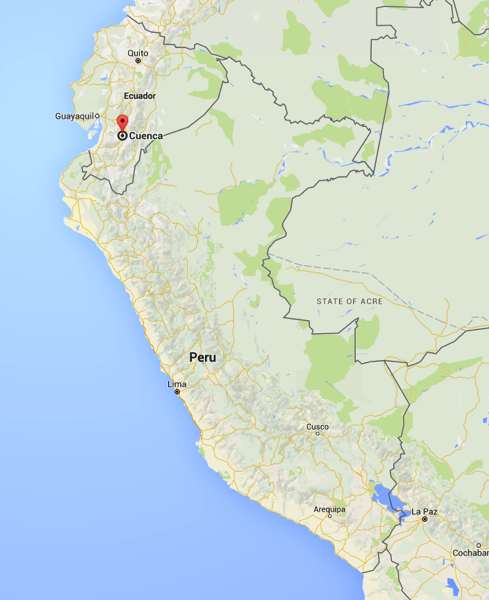
From Cuenca, there are two main ways to enter Peru:
- Head east and drive the slow gravel roads through the beautiful Andes mountains, or
- Head west and drive the fast and well-paved Pan-American highway through Peru’s coastal desert.
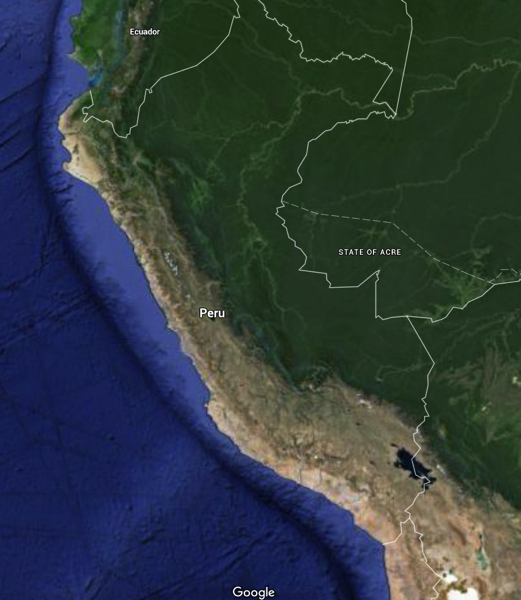
The beige-brown area in the west is desert. The brown-green relief in the east is the Andes.
Now, normally, we are mountain people. Lucky loves the mountains, too. So our natural instinct is to head for the mountains. Many overlanders strongly encouraged us to take the mountain route, saying that the desert highway is pretty boring and is plagued with corrupt cops, armed robbers, and smash-and-grab car thieves. However, other overlanders said that the desert highway is fast – an ideal route if you’re in a hurry. Well, we were in a hurry. So we suppressed our natural ‘mountain’ instincts and chose instead to enter Peru through the desert.
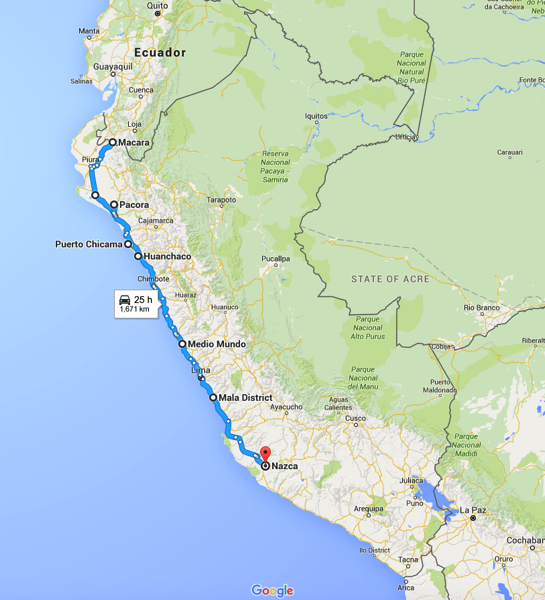
Our two-week route through the Peruvian desert (1671 km)
Before our border crossing, we stocked up on snacks and supplies in Cuenca and prepped Lucky for the road ahead.
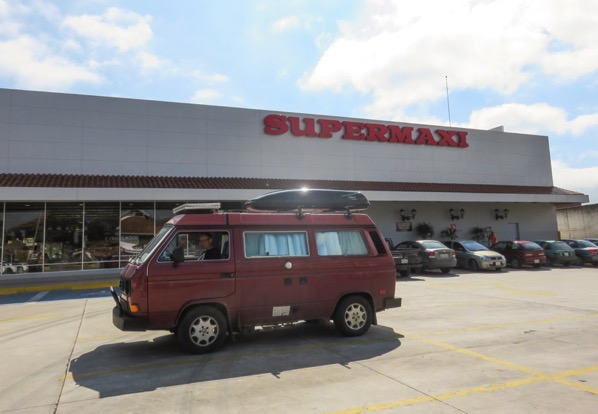
Our favourite supermarket in Ecuador
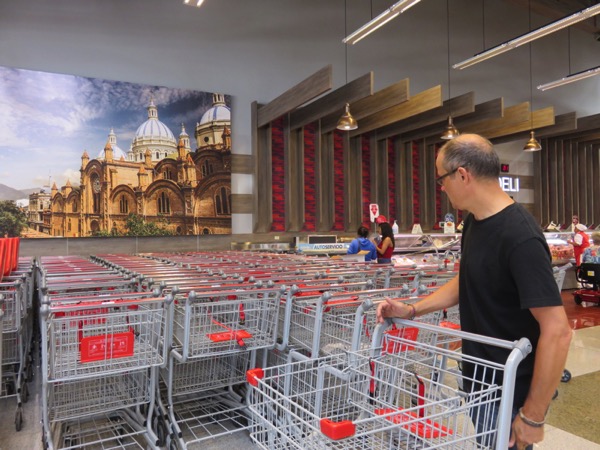
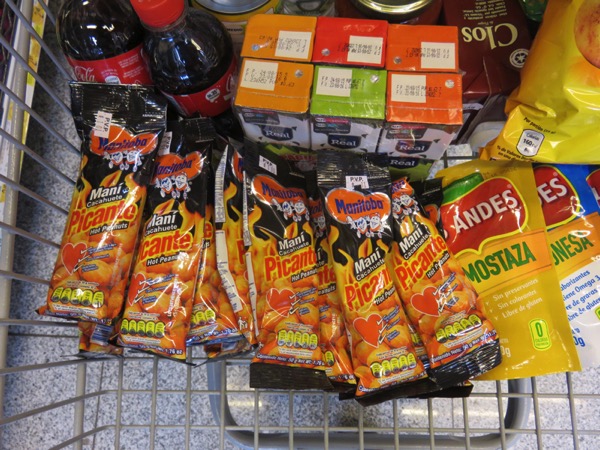
Gregor is totally addicted to these spicy peanuts

Lucky got a car wash before our border crossing.
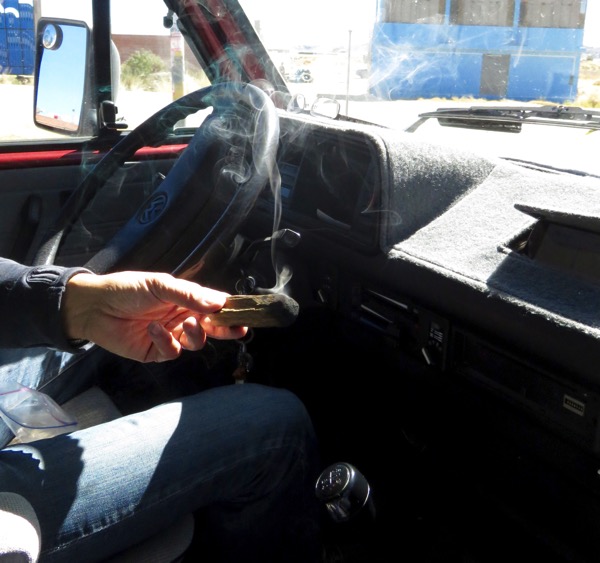
Before every border crossing, we always burn sandalwood (palo santo) to chase out any bad spirits from the van.
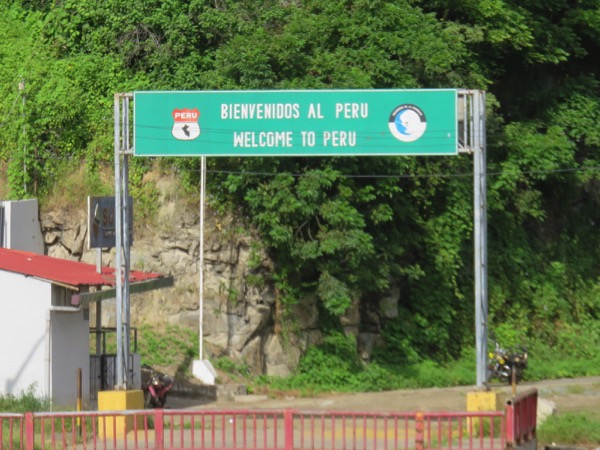
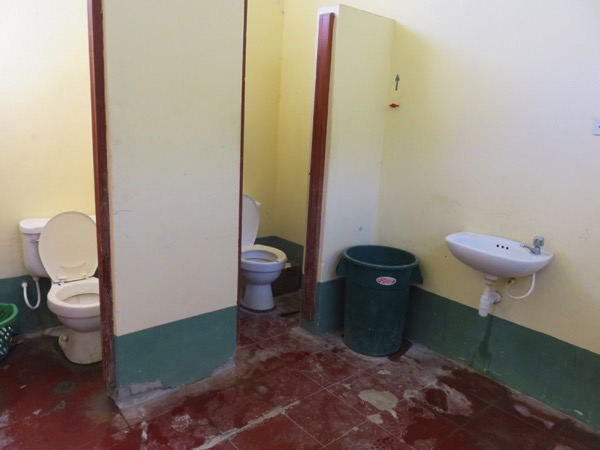
The pay-to-use bathrooms on the Peruvian side of the border.
Our border crossing was rather smooth, except that the guy at the Peruvian insurance office wanted us to pay three times the advertised cost to purchase mandatory vehicle accident insurance (in Peru, it’s called SOAT – Seguro Obligatorio de Accidents de Transito). With the help of our stellar Spanish translation app, SpanishDict, we negotiated one month of vehicle insurance for the more reasonable amount of $10 USD.
After dealing with the normal bureaucracy at the border, we gave each other congratulatory high-fives for having crossed into our 12th country. We couldn’t believe it – we made it to Peru!
Day 1 in the Desert
I remember being a pre-teen, sitting at my grandparents dining table staring at an Encyclopedia Brittanica volume with pictures of Peru. Mystical, enchanting, other-worldly Peru. Land of great Incan dynasties, hypnotic pan flute music, colourful hand-woven indigenous costumes, and fluffy alpacas and llamas.
Well, we didn’t see any of that stuff on our first day.
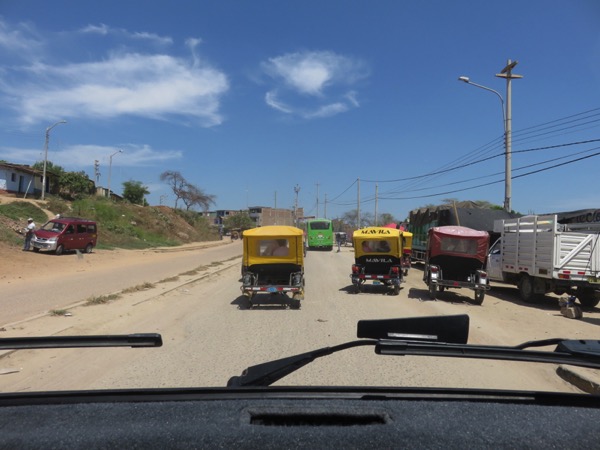
We saw a bunch of mototaxis – haven’t seen many of these since Central America.
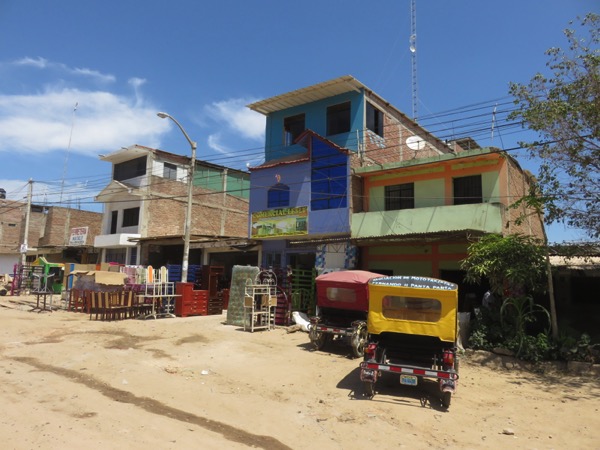
No sidewalks or driveways – just sand.
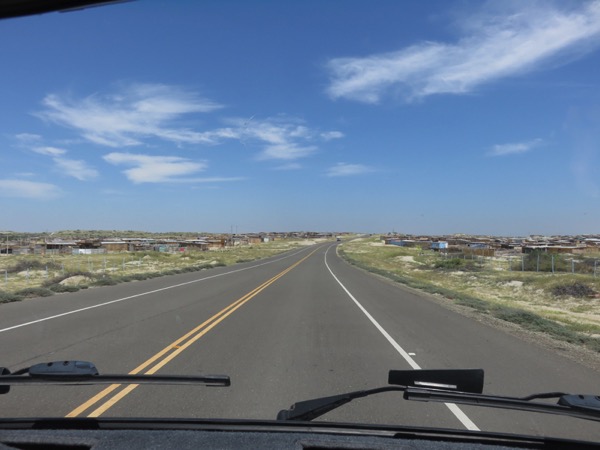
The Pan-American Highway
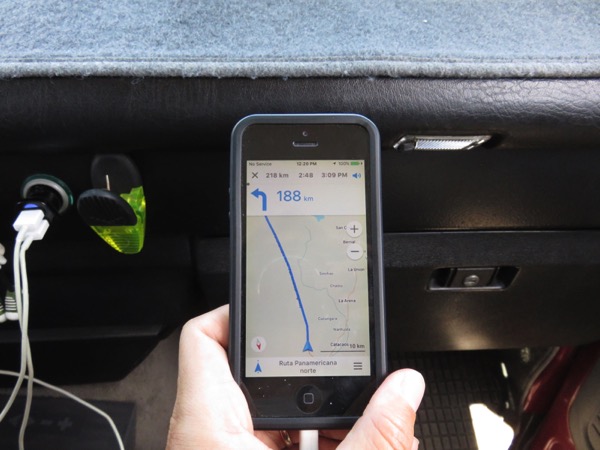
Next turn in 188 km. Cruise control activated!
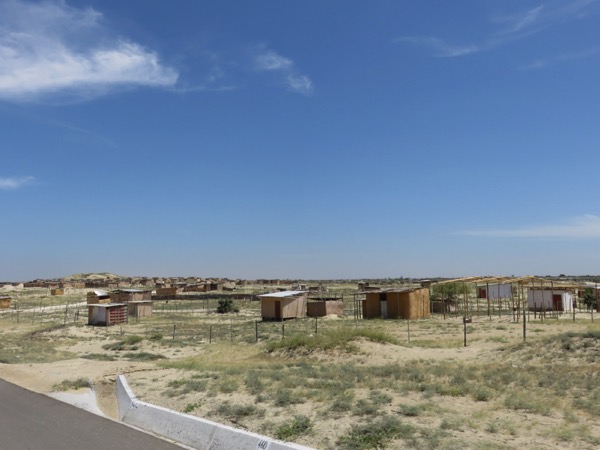
There were lots of bamboo shacks…
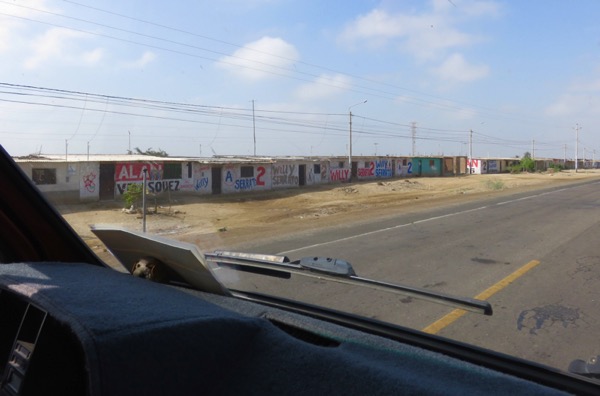
…and brick buildings painted with presidential election ads…
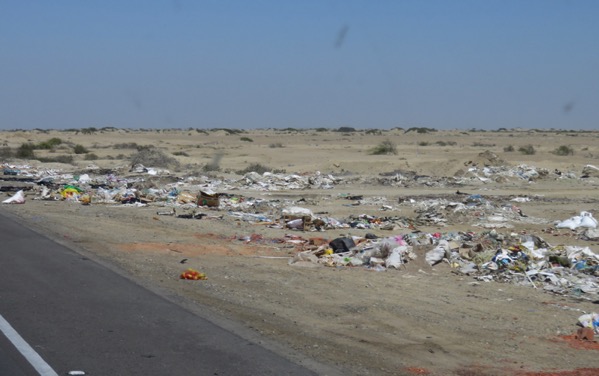
…and lots of garbage.
As we travelled southward from the border, the shanty towns and brick buildings became more scarce and we saw the occasional service station. Eventually, all the buildings disappeared and we saw only dry, flat desert.
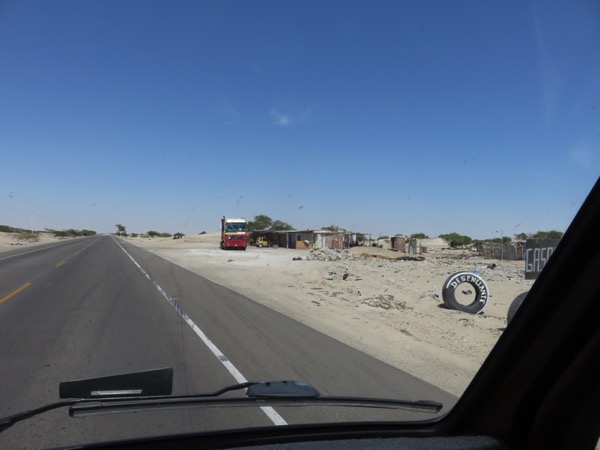
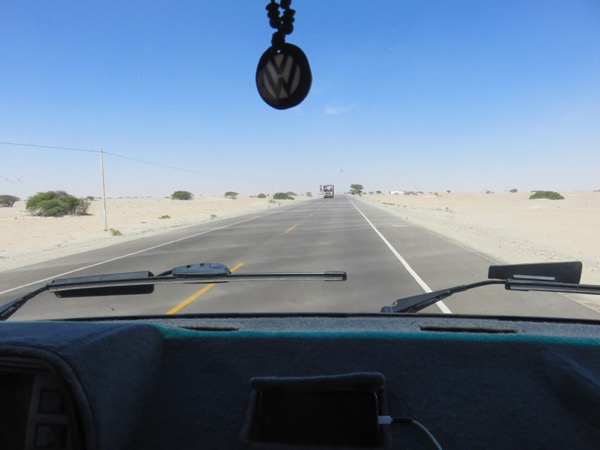
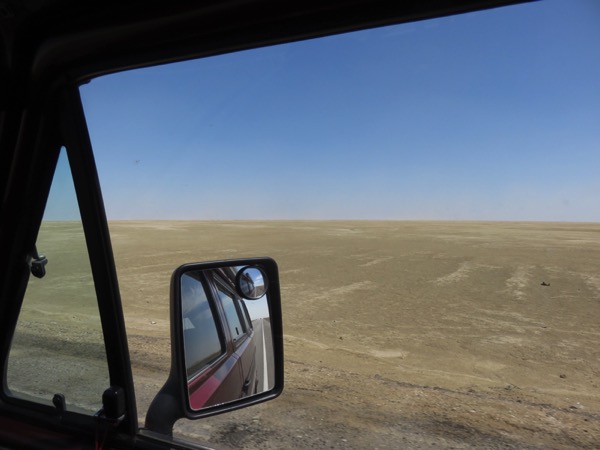
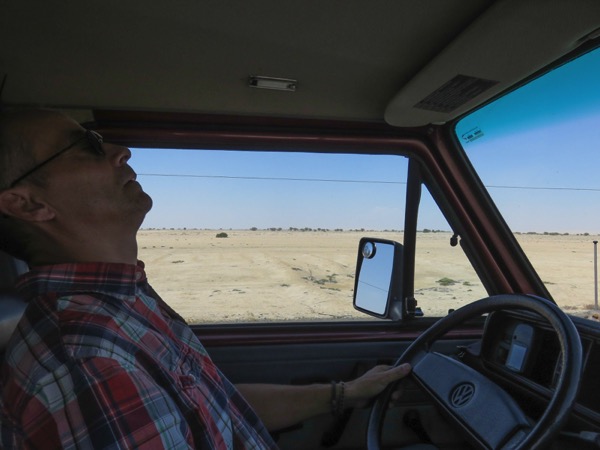
Gregor? You awake?
Just before sunset, we arrived at our first campground in Peru – Rancho Santa Ana in Pacora. The ranch was awfully sandy and had lots of chickens and horses wandering around. Sadly, there were no fluffy alpacas or llamas.
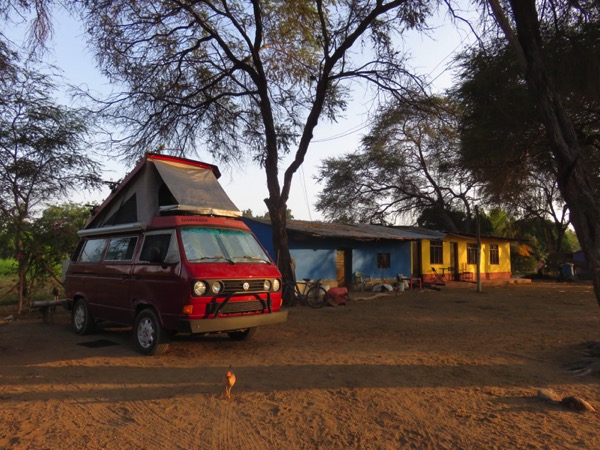
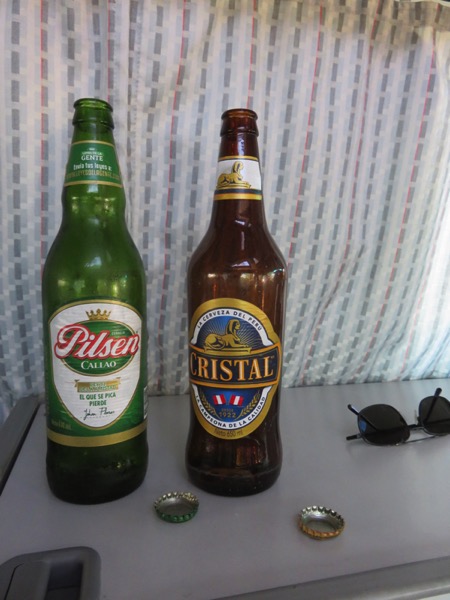
Celebrating our first night in Peru with a sampling of local beer
Day 2 in the Desert
On our second day in Peru, we drove through more dry, flat desert. There were more shacks, and more brick buildings painted with presidential election ads, and lots of garbage.
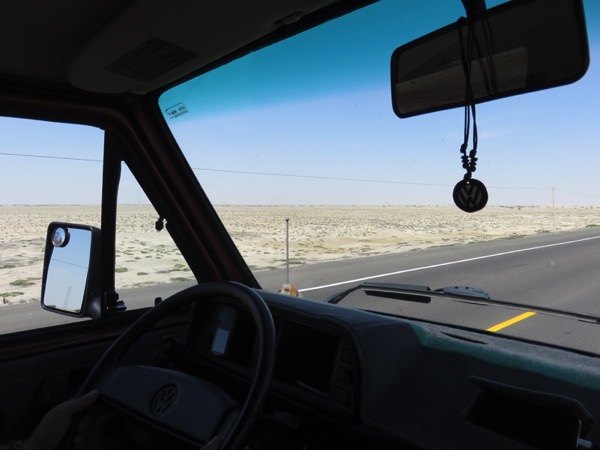
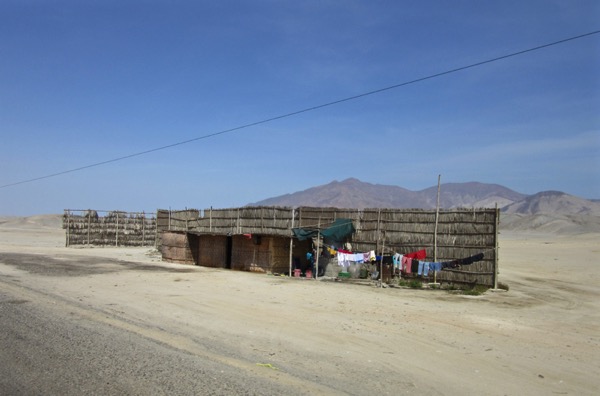
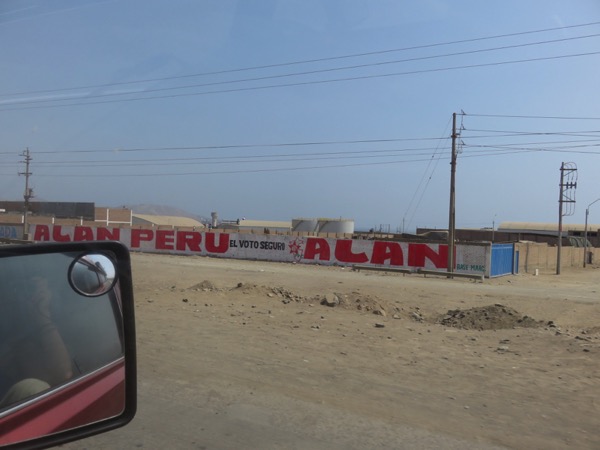
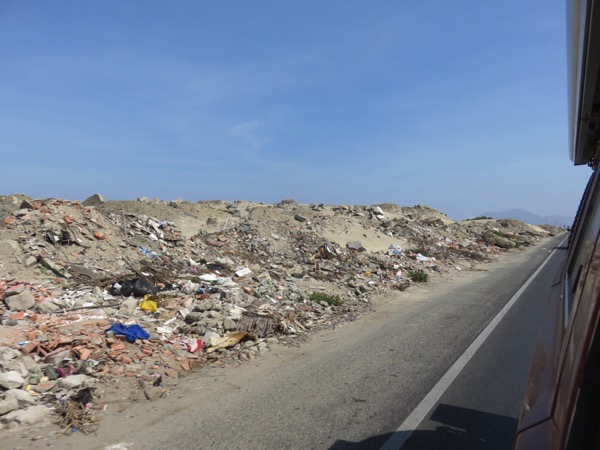
By midday we were starting to think that Peru was all hype. I mean, where were the majestic Incan ruins? What happened to the colourful indigenous people and the fluffy camelids? And why haven’t we heard any mesmerizing pan-flute renditions of super famous pop songs, like Abba’s “Chiquitita” or Celine Dion’s “My Heart Will Go On”?
The desert culture wasn’t exactly stimulating our senses, so we kept ourselves entertained by cranking the tunes, eating lots of snacks, and drinking the local bubble-gum flavoured soft drink ‘Inca Kola’.
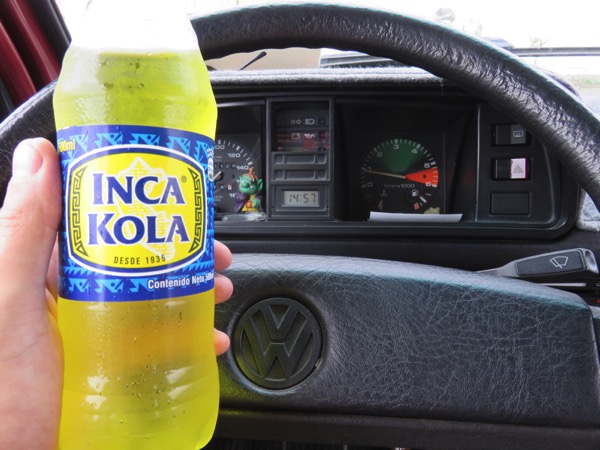
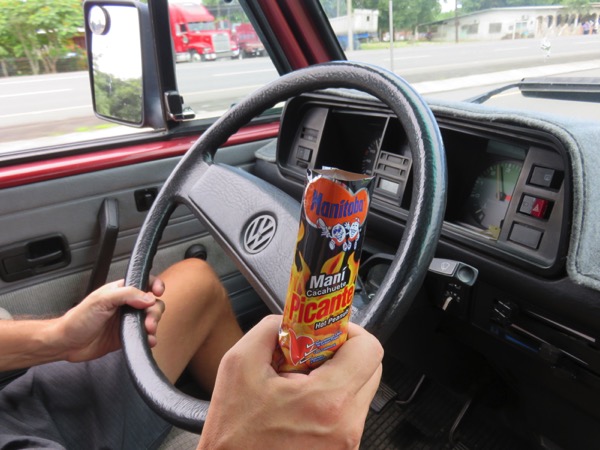
The Peruvian Police
Our destination for our second night in Peru was the coastal village of Puerto Chicama. Just before our exit off the Pan-Am highway, a police officer pulled us over. The cop pointed to the front of our vehicle, saying (in Spanish) that we didn’t have a front license plate and therefore he needed to give us a ticket. Basically, it was a shakedown and he wanted bribe money.
Having been warned about these crooked cops, we executed our shakedown protocol: I play dumb and pretend that I don’t understand Spanish. Gregor plays himself and keeps repeating in English “no entiendo” (I don’t understand).
The cop was pretty persistent, so Gregor proceeded to explain (in English) that there’s an international agreement that allows foreign vehicles with only one license plate to drive peacefully through any country. As you can imagine, the Spanish-speaking cop didn’t want to hear about it. After about 15 minutes of back and forth, the cop gave up and let us go.
Only 10 minutes later, just after the turn-off towards Puerto Chicama, another cop pulled us over. Same story: no front license plate, need to give us a ticket. But this time, the cop pulled out a ‘book of infractions’ and pointed to another item that required another ticket: no reflectors on our van.
It turned into a stand-off. Gregor kept saying “no entiendo”. The cop kept saying “infracciones multiples” (multiple infractions). It got a little intense and my palms were sweating. After about 20 minutes, the cop pulled out his ticket book and was about to write us up when he finally gave in. He simply told us to go. Just go.
Both of us were pretty agitated after the shakedowns, but the tension melted away as we watched the sunset at Puerto Chicama.
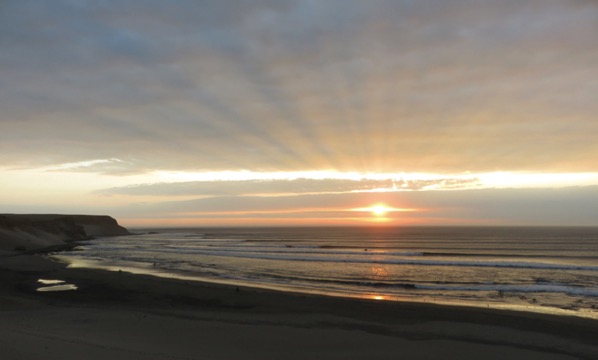
Puerto Chicama’s famous one-kilometre long surfing waves
Taking a Break in Huanchaco
Huanchaco is a coastal town that is a popular weekend destination for residents of the nearby city of Trujillo. Here, local and international tourists can enjoy sunbathing, surfing, sunset-watching, and eating stellar seafood. The water in this part of the world is very chilly due to the Humboldt current, so surfers need to wear wetsuits and swimmers need to be thick-skinned. We didn’t swim or surf – we just wanted to chill on the beach after Gregor’s work days.

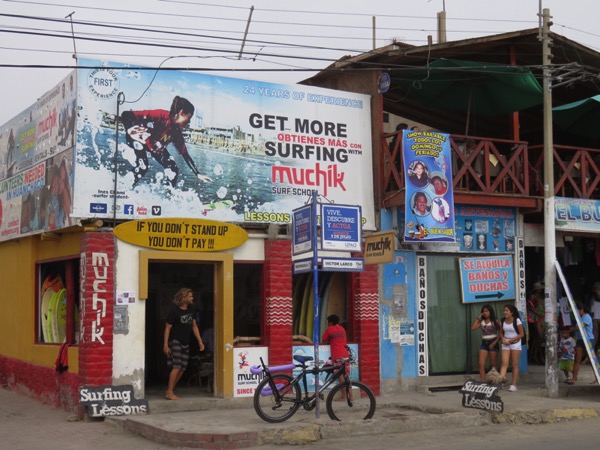
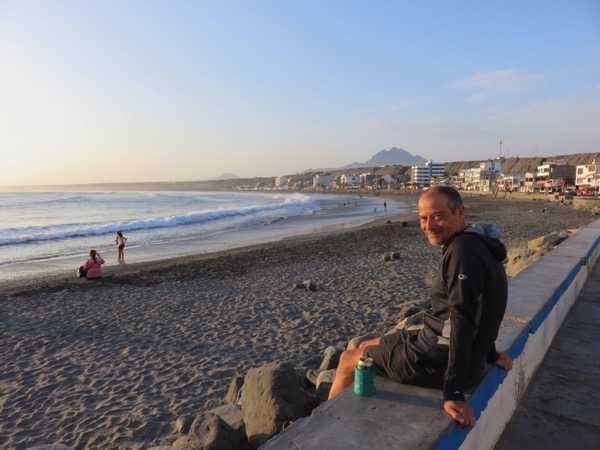
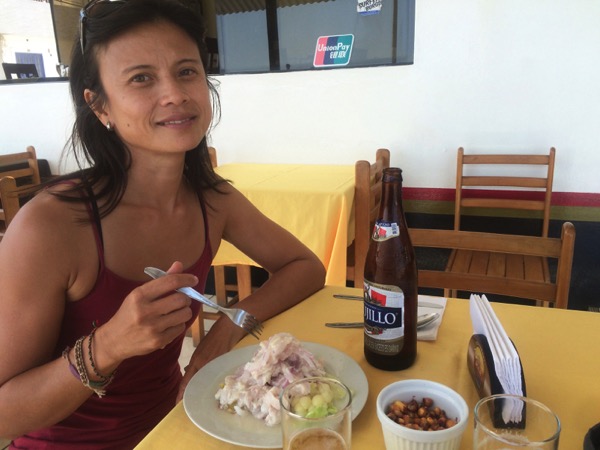
Coastal Peru has amazing ceviche (lime-cured fish).
Huanchaco is most famous for its artesenal fishing tradition, in which fishermen paddle out in little reed boats to catch just enough fish to sell to a local restaurant or to feed their family for the day.
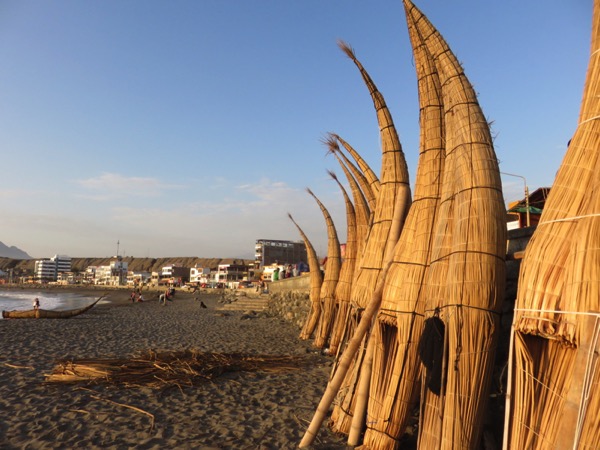
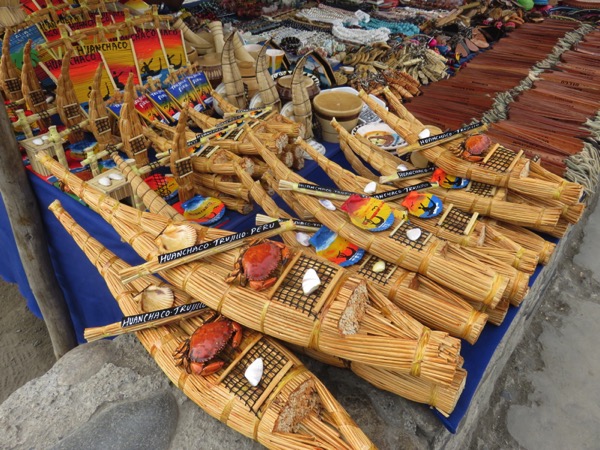
You can buy miniature reed boats as souvenirs.
Unfortunately, Gregor came down with the flu on our second morning in Huanchaco. His head was all stuffed up and he was achy all over. My poor husband ended up cooped up in the van for five days to recuperate.
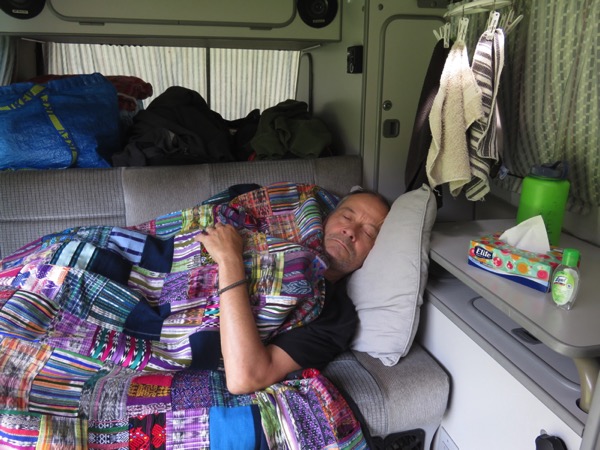
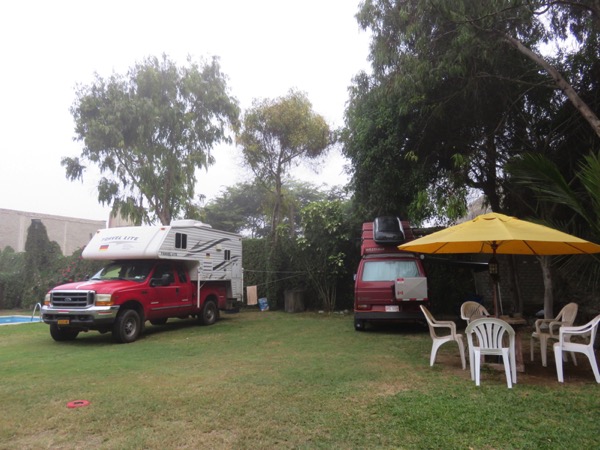
Our campsite at Huanchaco Gardens Hotel and RV Park
Chan Chan Ruins
Rather than watch Gregor snooze and sniffle, I took a bus to Chan Chan archeological site, the largest Pre-Columbian city in South America. The city is thought to have been built around 850 AD by the Chimú culture and was the capital of the Chimor Empire until it was conquered by the Inca around 1470 AD. The most unique features of the city are the intricate designs on its adobe brick walls.


Squirrels!
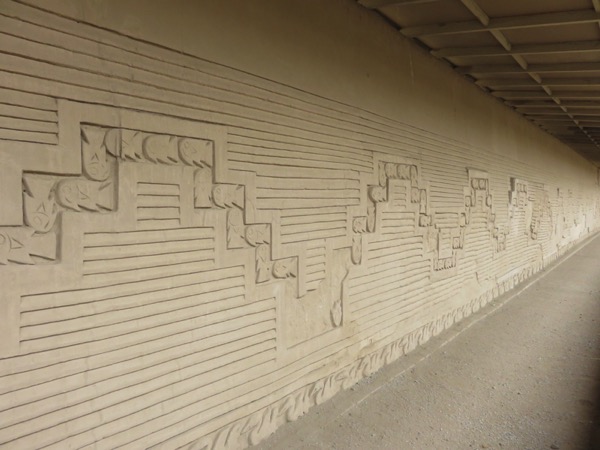
Fish was the main food source for the Chimú culture.
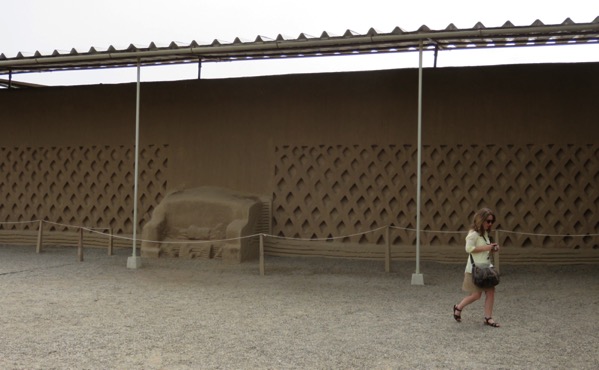
The diamond-shaped pattern represents a fishing net.
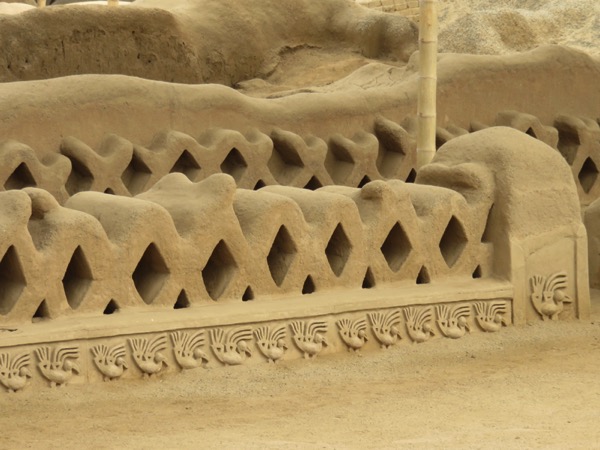
The base of the wall features pelicans, which were domesticated by Chimú fishermen to help locate fish.
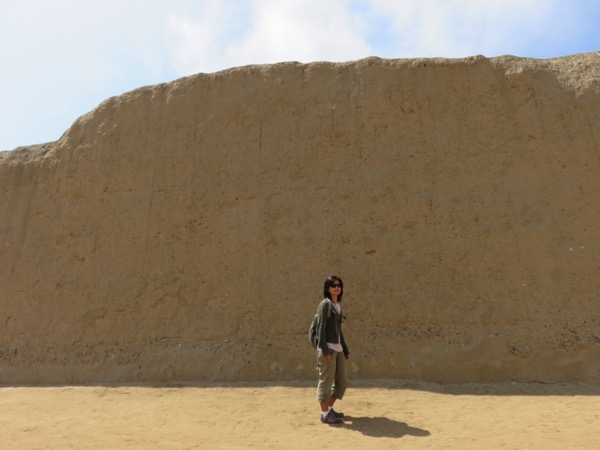
So I didn’t find majestic Incan temples at Chan Chan, but I did see the remains of an ancient civilization that appeared to have worshipped squirrels. And while I didn’t get to pet any fluffy llamas or alpacas, I did see a Peruvian hairless dog for the first time:

I saw this bald pooch at the Chan Chan museum.
A Chance Encounter
Once Gregor started feeling better, we took short walks around Huanchaco so that he could gain back some strength. On one of our morning walks, we talked about driving to the nearby city of Trujillo to get a fake licence plate made up for our front bumper (so that we wouldn’t get hassled by the nasty Peruvian police). The problem was that we didn’t want to drive aimlessly through crazy city traffic searching for a shop specializing in illegal automotive paraphernalia.
At that moment, we passed by a Peruvian guy loading surfboards on his passenger van. “Good morning!” he said cheerily, “Are you going surfing today?” I politely replied, no, we were just resting today. And that was our first encounter with Dario and his family.
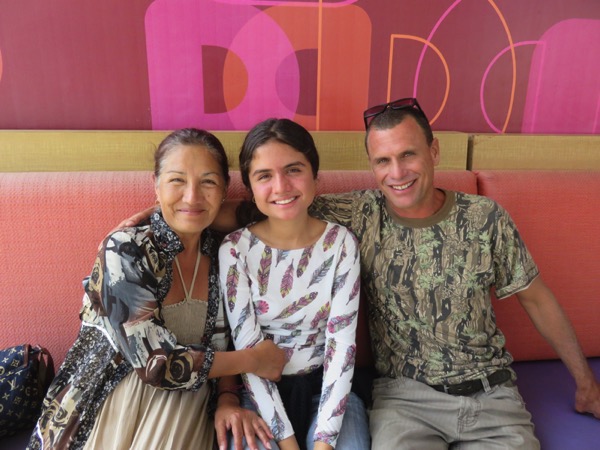
Dario with his wife, Gigi, and daughter, Kayla.
Originally from the capital city of Lima, Dario and Gigi moved to Huanchaco to live a simpler life by the ocean. They started a tour company called Descubriendo el Norte, which offers private transportation to surf spots and tourist sites around Huanchaco. Their teenaged daughter, Kayla, sometimes joins the tours so that she can meet other travellers and practice her English.
We hired Dario to drive us to his friend’s shop in Trujillo to get fake plates made at a fair price. Gigi and Layla joined us, too. As we rode in the van, they chatted about Peruvian culture and we shared our travel experiences. It was a perfect arrangement.
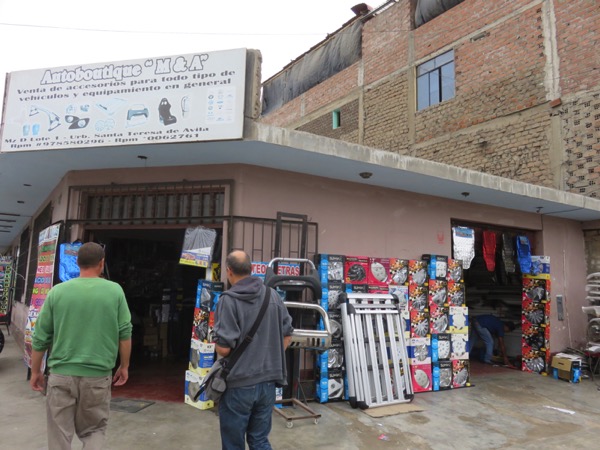
The shop where we got our fake licence plate
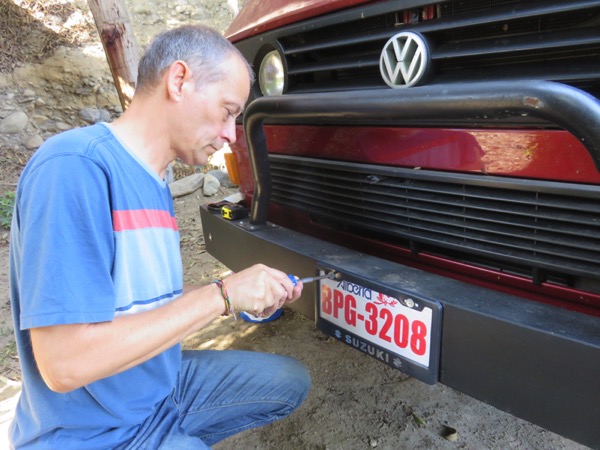
The plate is made of plastic and custom stickers.
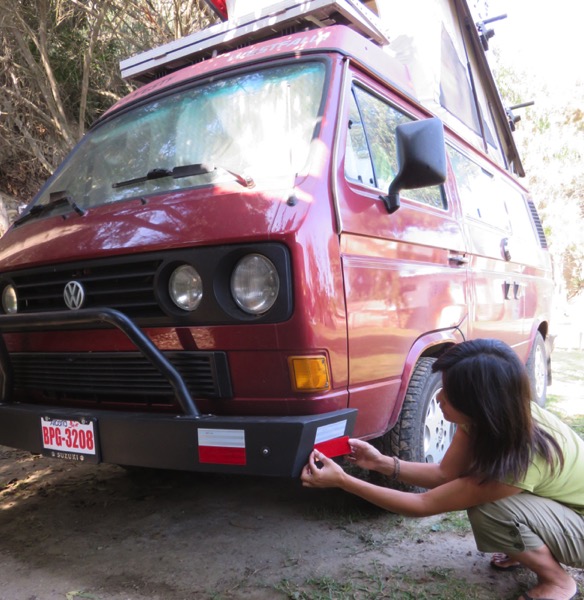
We also bought reflective stickers to fend off the police.
The best part about this story:
After installing the front plate and reflectors, we were never hassled by the Peruvian police again.
The most bestest part about this story:
Well, we didn’t meet any colourfully-clad native Peruvians, but we did spend time with a lovely local family who wanted us to remember their country for the good things it has to offer – not for the bad encounters with corrupt police.
Finally, Some Pan Flute Music
Gregor got his appetite back after one week of rest in Huanchaco. We decided to treat ourselves and have a gourmet seafood dinner at Big Ben Restaurant, which was recommended to us by our friends, John and Paula (OurBiggerPicture.com). The food was delicious.
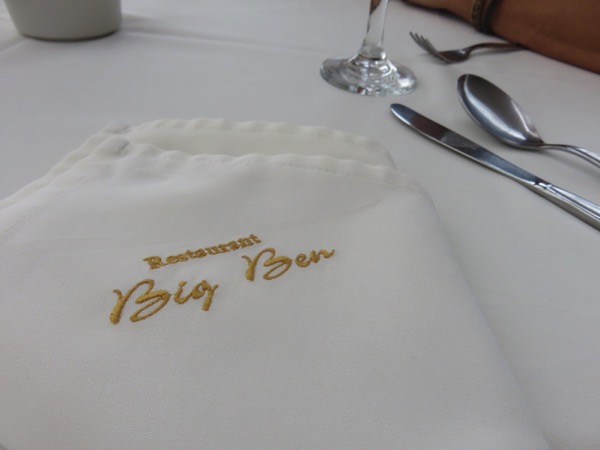
Look, Gregor, embroidered cloth napkins!
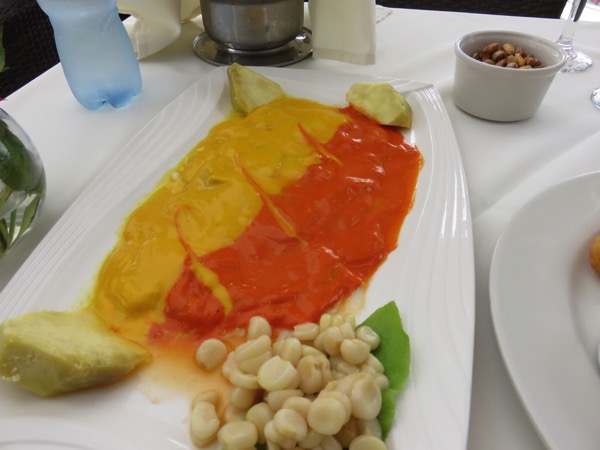
Tiradito, a Peruvian dish of raw sashimi in a spicy mustard-based sauce, inspired by Japanese immigrant cuisine.
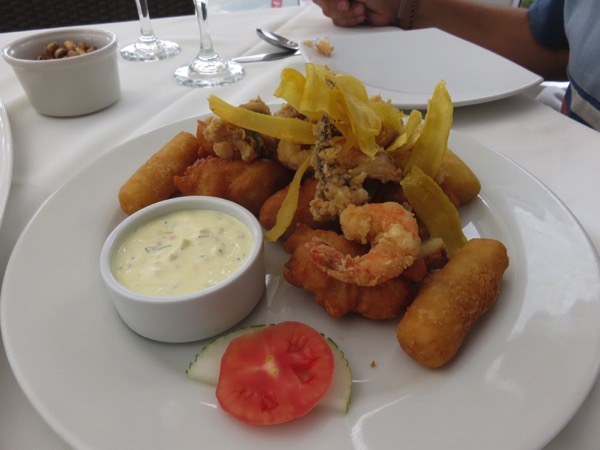
Deep fried goodness
As we devoured our meal, I heard pan flute music playing over the restaurant’s speakers. I recognized the tune: “Winds of Change” by the German hair band, Scorpions. When I pointed it out to Gregor, he stopped chewing and gave me a big, happy smile. Zamfir totally made our day.
Here’s Scorpions’ original English version of “Winds of Change”, recorded in the ‘90s:
Here’s Zamfir’s pan-flute version:
Totally random and wacky, right? Really, it’s the small and simple things that give us joy in this world.
Back in the Desert
Gregor was finally fit to drive again and we continued our race through the desert. We drove over 1000 km in 3 days, from Huanchaco to Nazca.
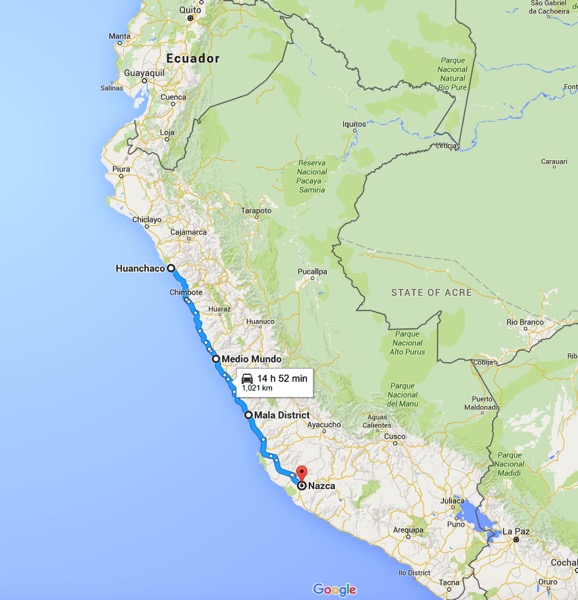
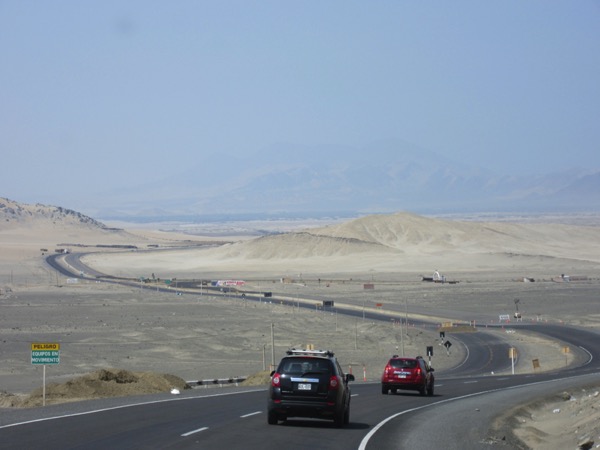
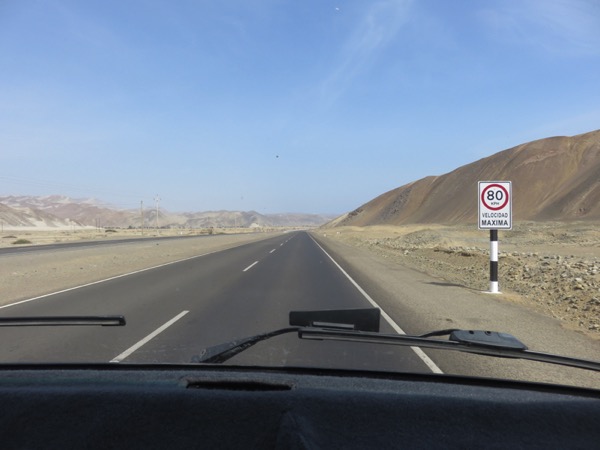
80 km/h is pretty fast for us…
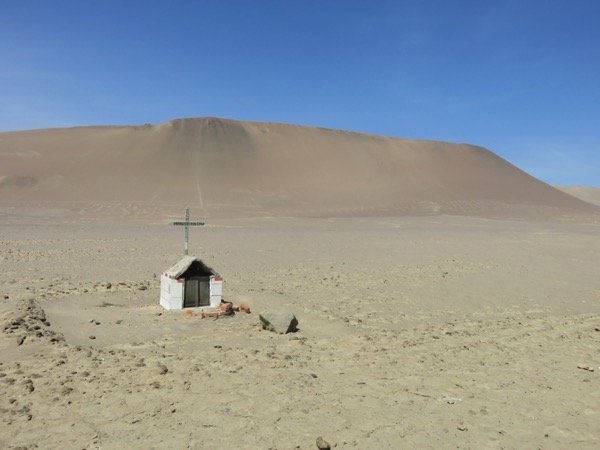
…but judging by the number of memorials we saw, it’s not fast enough for the locals.
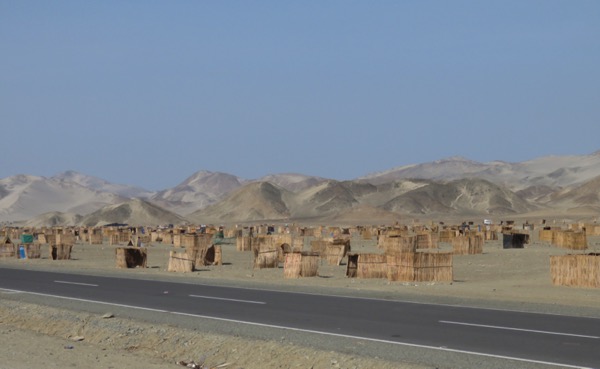
Bamboo shacks
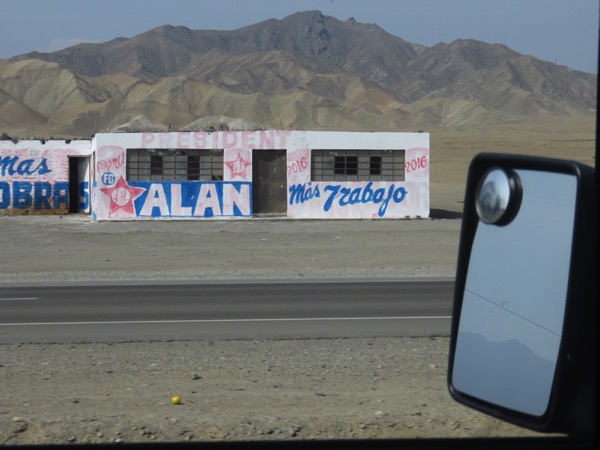
Presidential campaign propaganda

Garbage
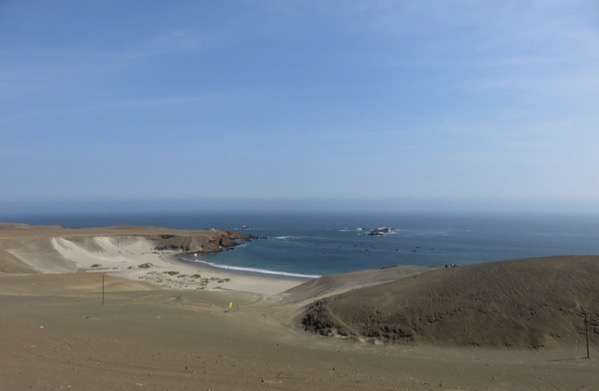
Occasionally, we got a glimpse of the ocean.
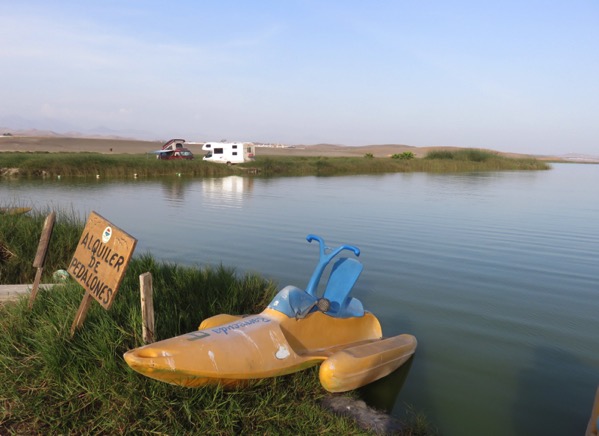
Our camping spot at a lagoon in Medio Mundo
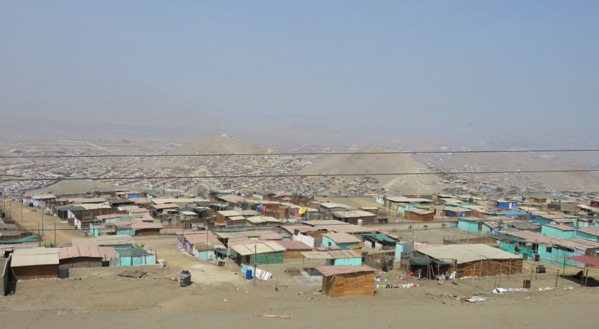
As we approached Lima, the bamboo settlements morphed into shanty towns.
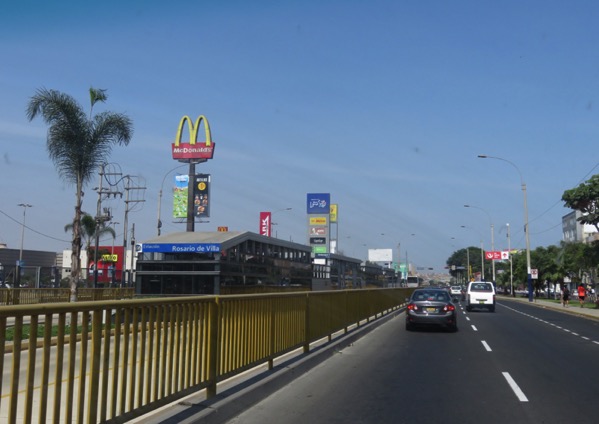
We raced through Lima’s suburbs…

…and Lima’s downtown beachfront.
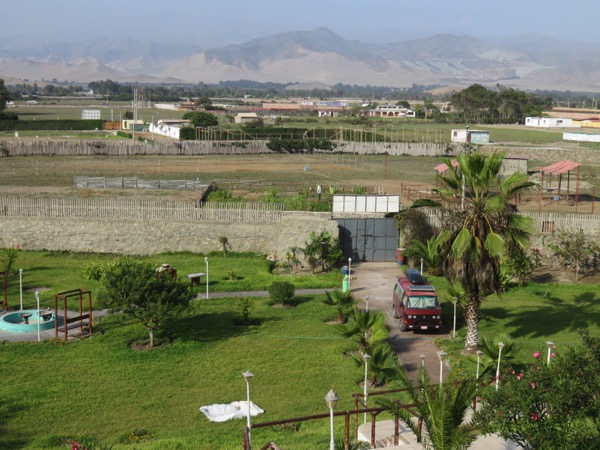
We parked at a hotel in Mala for the night.

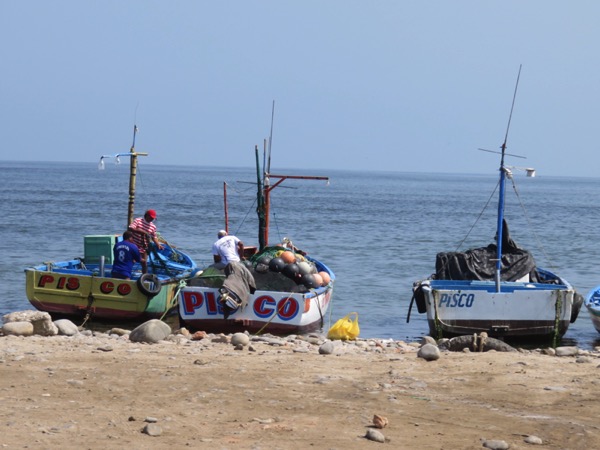
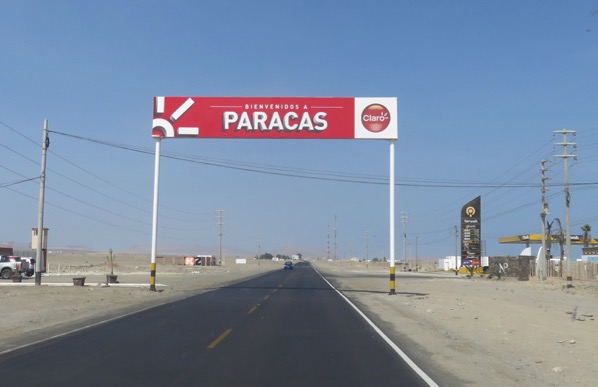
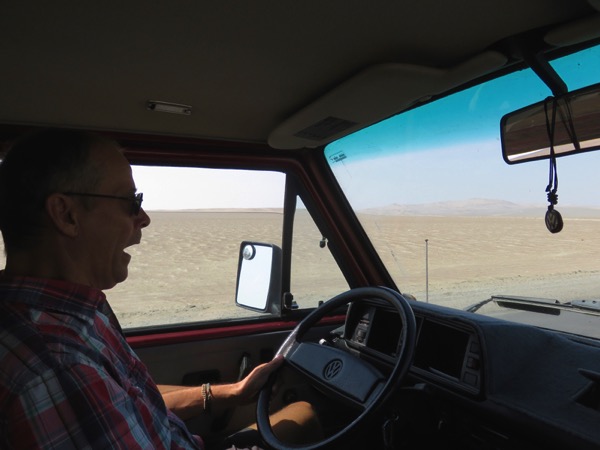
Gregor, stay awake!
The scenery started to get really interesting when we entered Paracas National Reserve, a pristine area that protects the marine habitat and coastal desert around the Paracas Peninsula. We had tons of fun going off-road to explore the desert terrain.
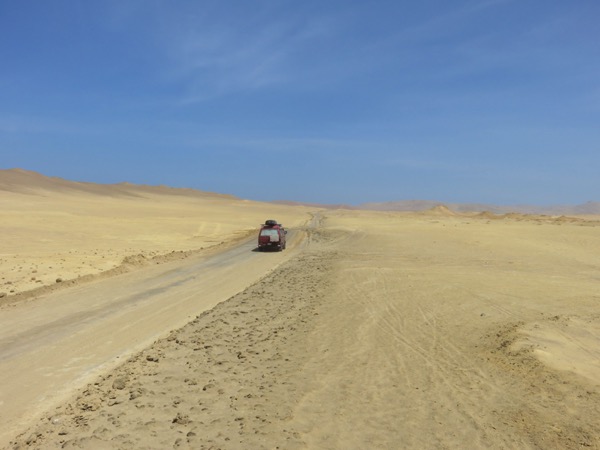

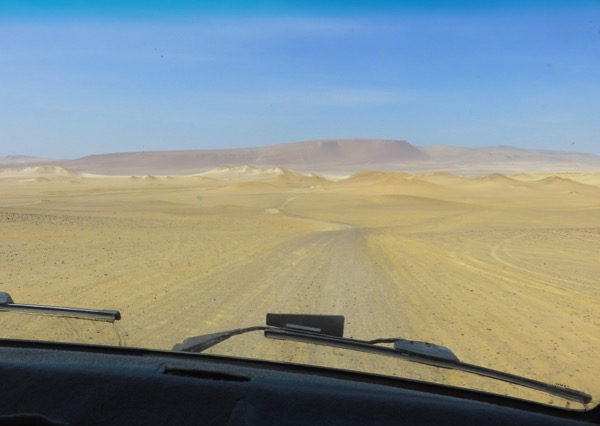
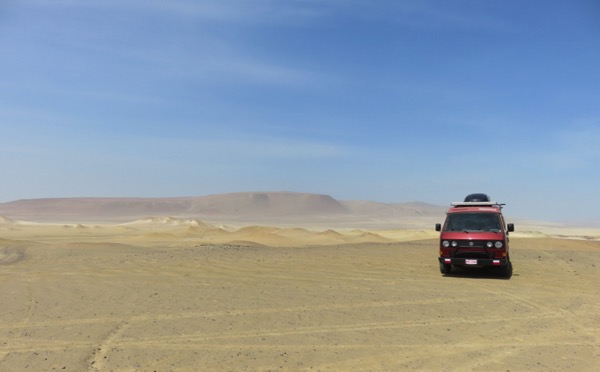
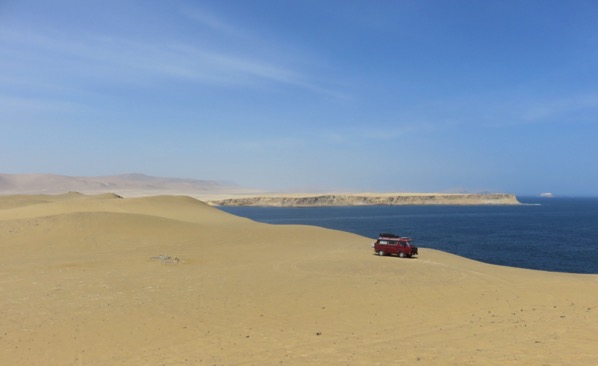
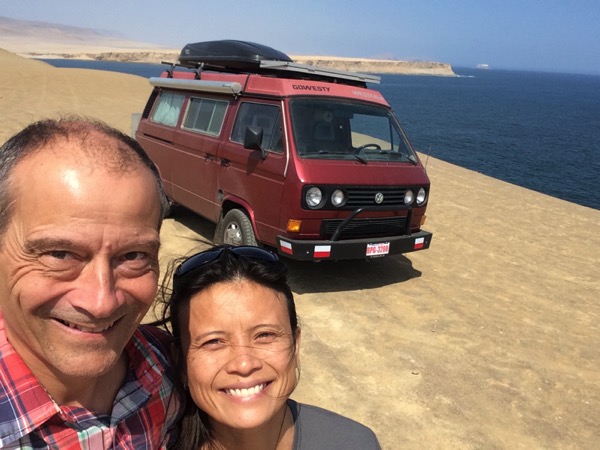
Gregor and I were a little bit sad when we returned to the asphalt of the Pan-American highway, but we had to keep moving.
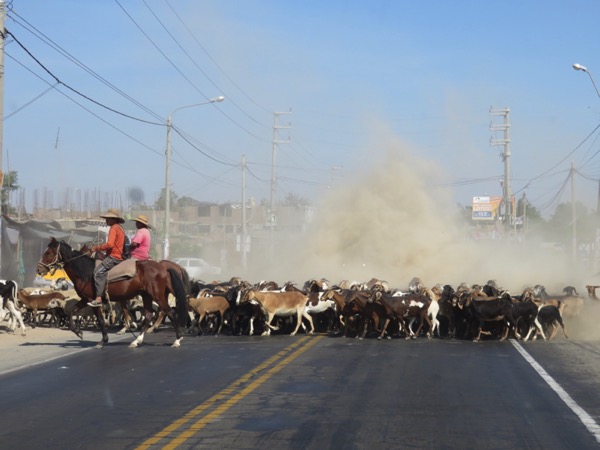
Still no fluffy alpacas or llamas.
The Nazca Lines are series of mysterious geoglyphs located in the Nazca desert. The area is a UNESCO World Heritage Site containing hundreds of geometric shapes and animal figures, believed to have been created by the ancient Nazca culture between 500 BC and 500 AD. No one is sure why the lines were created, but judging by their size (some of the figures are over 200 m across) they were probably kind-of-a-big-deal back in the day.
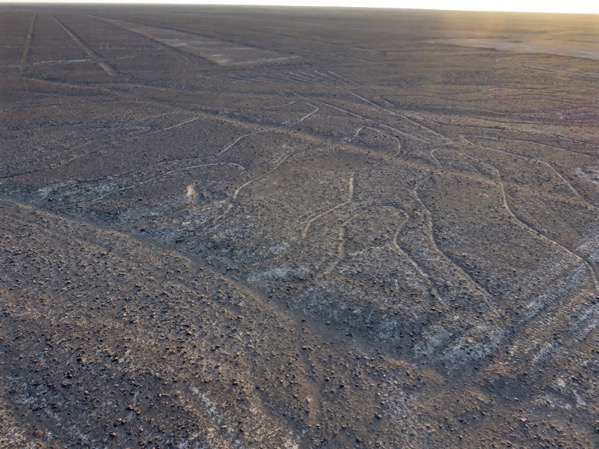
You can see the lines by purchasing a 35-minute airplane ride ($65 USD), or by walking up to a viewing platform ($1 USD). We chose the cheaper option.

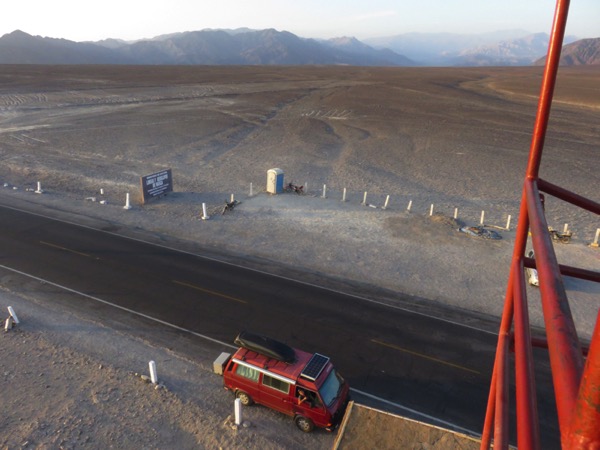
By the time we arrived in the town of Nazca, we realized that the Peruvian desert does have elements of beauty and mystery. Yes, our hearts belong in the mountains, but the places where desert sand meets open ocean are pretty spectacular, too. No, we didn’t see majestic Incan ruins, or traditionally dressed natives, or fluffy alpacas and llamas. However, we did hear Scorpions on the pan flute and that brought us great joy.
For all those hair-band fans out there, here is Scorpions’ Spanish version of “Winds of Change” (Vientos de Cambio):

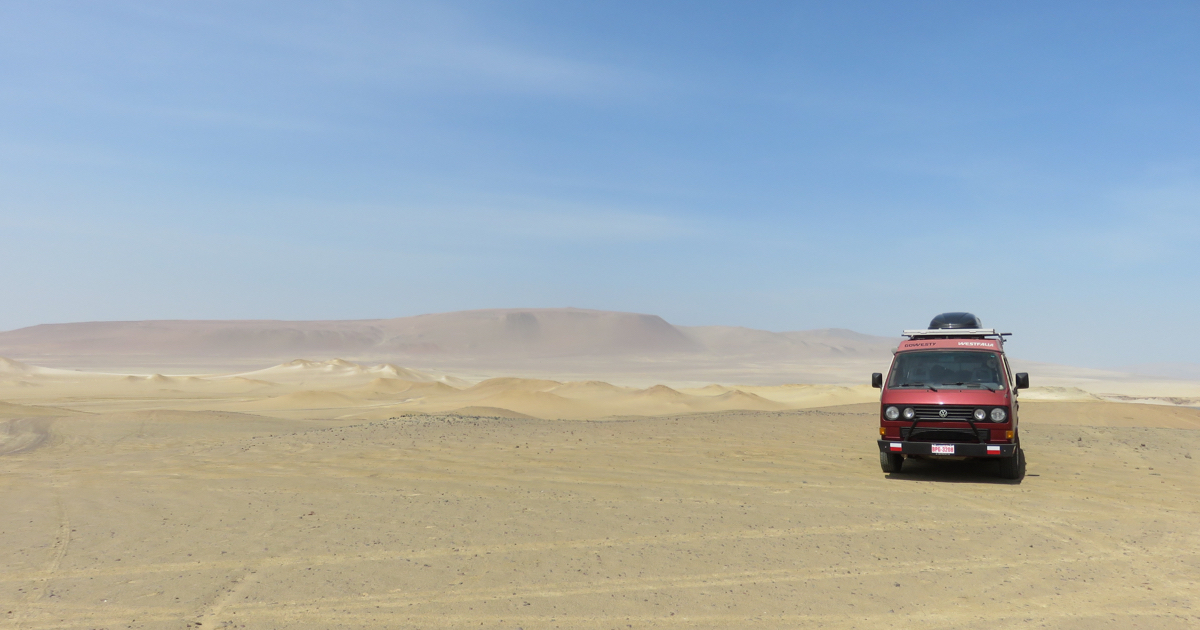

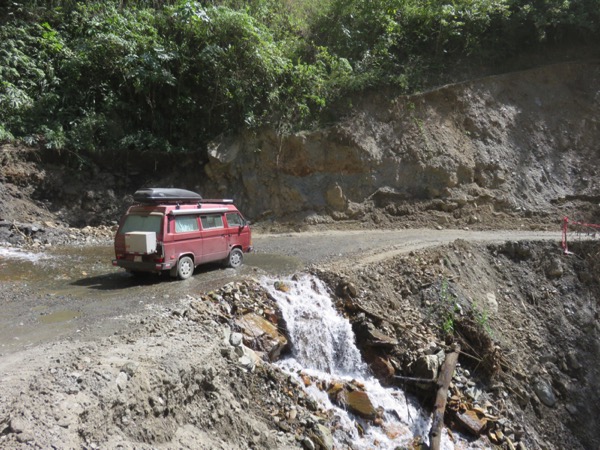
Janice, great blog post as always. It is such a pleasure to keep up on your travel adventures – and occasional misadventures – in this way.
How ironic that you opted for the “faster” approach to traveling through Peru, and then Gregor promptly falls sick and has to lay up for a week. I guess when you’re in a Westy, all roads are slow roads. 🙂
Can’t wait for the next update!
Much love
Ted
You’re absolutely right, Ted. I think the universe is trying to tell us that rushing is futile! Lots of love back to you and Cheryl 🙂
Great advice with the added front licence plate and reflectors, to avoid shakedowns as much as possible. Got a link to your blog after our first post and pending travels. Very nice to read of your adventures. All the best to you on your continued journey. Cheers Dr.D and Andi
http://www.drdnaturopath.com/index.php/starting-our-minimalist-lifestyle-journey/
Thanks for reading, Andi. I hope your future travels are shakedown-free! Looking forward to seeing more of your posts.
Great post! Love that Tiradito! See you soon i hope!
Hey, thanks for recommending Big Ben – such a treat! We though about you lots in Huanchaco. The food in Peru was so good. Hope to share some Bolivian food with you guys soon 🙂
It’s so much fun reading about your experiences! Thank you for taking so many pictures, fabulous to see 🙂
Hey, glad you liked the pics! Desert sand is definitely different from beach sand. So weird not to see green plants for hundreds and hundreds of kilometres. But it was interesting to see. Miss you guys!
I always enjoy reading about your adventures. I’m not sure if I ever want to drive through the deserts of Peru, but I’m glad to vicariously live through your experiences. Good to hear that the Peru stickers and fake license plate did the trick!
I love that you burn palo santo after border crossings! I love palo santo too. I used to burn it too! I think it’s similar to sandalwood, but a different species.
I love the pic of your smiling faces at Paracas National Reserve. Miss you guys!
I think the palo santo has been working for us – it’s a nice ritual and it makes Lucky smell good. I’m glad that our experiences are saving you from a needless trip to the desert!
You guys are amazing….thanks for sharing this crazy adventures with us comfortably sitting on our patio with a nice drinks and thinking: I will not want to be in your shoes stuck with an angry police officers or crossing the desert wandering if my car is going to make it…. SO BIG THANKS, we miss you, and be safe OK !
Ha, ha, the desert is definitely a crazy place. But we also made the crazy decision to drive through it, so which one is crazier? Would love to be sitting on a patio with you guys right now. Miss you!